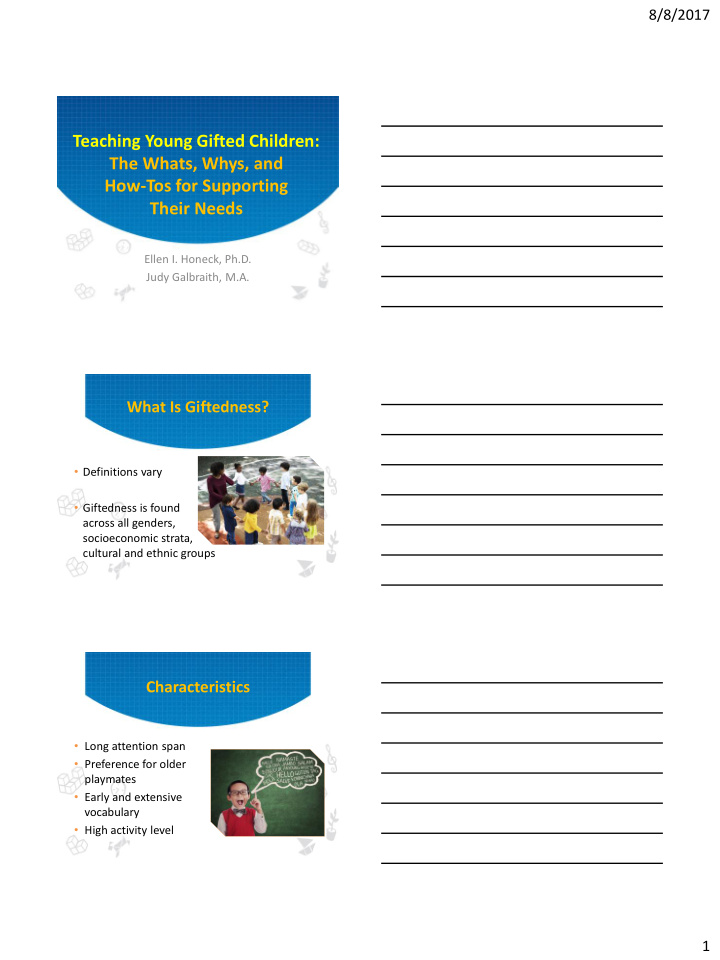



8/8/2017 Teaching Young Gifted Children: The Whats, Whys, and How-Tos for Supporting Their Needs Ellen I. Honeck, Ph.D. Judy Galbraith, M.A. What Is Giftedness? • Definitions vary • Giftedness is found across all genders, socioeconomic strata, cultural and ethnic groups Characteristics • Long attention span • Preference for older playmates • Early and extensive vocabulary • High activity level 1
8/8/2017 Characteristics • Excellent memory • Extreme curiosity • Keen sense of observation • Rapid learning ability Characteristics • Excellent sense of humor Characteristics • Excellent sense of humor • High degree of sensitivity 2
8/8/2017 Characteristics • Excellent sense of humor • High degree of sensitivity • Abstract reasoning Social-Emotional Characteristics • Support intensity and sensitivity – Emotional – Behavioral – Attitudes – Interests Asynchrony • Experiences that are qualitatively different from the norm • Peaks and valleys 3
8/8/2017 Giftedness is like a symphony . . . both encompass a spectrum of qualities. Recognize Strengths and Interests • A young child who is provided with appropriately challenging, stimulating school work can show substantial gains in achievement, motivation, and self-concept. Diverse Populations • Supportive environment • Look and listen • Use a strength-based approach • Understand not all gifted children look the same 4
8/8/2017 So I think there are gifted children in my classroom. Now what? How do I meet the needs of the gifted child? Utilize a wide variety of differentiation and instructional strategies Selecting Differentiation Strategies • Relate to instructional purposes • Be diverse • Provide a balance • Mesh with the learning styles • Subordinate to educational purpose 5
8/8/2017 Quality Differentiation • Use a variety of resources • No upper limit on expectations • Facilitation emphasis by teacher • Study of topics from multiple perspectives • More extended and involved Quality Differentiation • Higher-level thinking • Product alternatives • More open-ended (creative responses) • More conceptual or abstract • More complex • More focused on analysis or interpretation Environmental Strategies • Value the competencies of the young child 6
8/8/2017 Environmental Strategies • Value the competencies of the young child • Appreciate and enjoy the uniqueness Environmental Strategies • Value the competencies of the young child • Appreciate and enjoy the uniqueness • Become listeners Environmental Strategies • Value the competencies of the young child • Appreciate and enjoy the uniqueness • Become listeners • Maintain high expectations 7
8/8/2017 Environmental Strategies • Make explicit the language of thinking Environmental Strategies • Make explicit the language of thinking • Create a literacy rich environment Environmental Strategies • Make explicit the language of thinking • Create a literacy rich environment • Celebrate diversity 8
8/8/2017 Specific Environmental Strategies • Inclusion of the arts • Allowing for socialization • Interest centers • Grouping arrangements • Multicultural considerations Curricular Strategies • Provide authentic learning experiences • Provide choices to engage learning • Opportunities for inquiry • Assess continually Specific Content Strategies • Pre-assessment • Open reading choice • Bloom’s taxonomy • Allowing for readiness and prior knowledge • Bibliotherapy 9
8/8/2017 Tiered Lessons • Centers can have varying difficulty levels at the stations for the students • Multiple groups and activities happening at the same time • Great way to scaffold (up and down) Assessment • Differentiation only works with continual assessment – Pre-assessment – Formative – Summative – Student self-assessment Specific Process Strategies • Pacing 10
8/8/2017 Specific Process Strategies • Pacing • Inquiry and discovery Specific Process Strategies • Pacing • Inquiry and discovery • Questioning techniques Specific Process Strategies • Pacing • Inquiry and discovery • Questioning techniques • Problem solving 11
8/8/2017 Specific Process Strategies • Pacing • Inquiry and discovery • Questioning techniques • Problem solving • Problem-based learning Specific Process Strategies • Pacing • Inquiry and discovery • Questioning techniques • Problem solving • Problem-based learning • Learning opportunities for multiple forms of intelligence Compacting or Extending the Curriculum • Compacting – Compress the basic curriculum into a smaller time frame – Individualize one or more parts of the curriculum to facilitate and challenge a gifted child • Extending – Provide additional depth and complexity 12
8/8/2017 Specific Product Strategies • Journals • Portfolios • Product choice — open-ended creative options Tic-Tac-Toe Menu • Ability to provide various activities so students have choice • Menu boards can be set up in a variety of ways focusing on products, process, or content Thinking Skills • Creative thinking • Critical thinking • Mathematical thinking 13
8/8/2017 Critical and Creative Thinking • Goals – Use creativity as a channel for critical thinking – Explore a range of subjects – Make discoveries – Build connections – Become participants and contributors Creative Thinking Taxonomy • Fluency • Flexibility • Originality • Elaboration • Evaluation Adapted form E. Paul Torrance, The Search for Satori and Creativity, Buffalo, NY: Creative Education Foundation, 1979. Used with permission of E. Paul Torrance. Into Practice • Step 1: Set the stage • Step 2: Depends on which taxonomy level – Generate solutions – Imagine – Explore and share – Questioning • Step 3: Make the link to critical thinking 14
8/8/2017 Mathematical Thinking • Discovery of properties • Discovery of process Family Partnerships • Have the family share information about their child • Provide open communication • Provide support As an educator, your goal is to make sure that you extend the excitement and nourish the curiosity of all children, including young gifted children. 15
8/8/2017 Contact Ellen and Judy Judy Galbraith, M.A. Ellen I. Honeck, Ph.D. galbraith@freespirit.com honeck@comcast.net Twitter: @judyfreespirit Twitter: @EllenHoneck 16
Recommend
More recommend